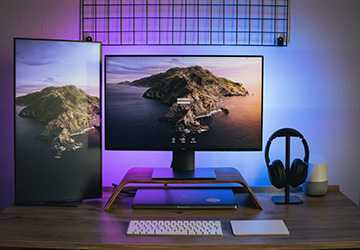What are the Benefits of a Dual Monitor Setup?
Increase productivity: dual-monitor revelations.
One of the most compelling benefits of dual monitors is the dramatic increase in productivity. Most of us have experienced the frustration of switching between tabs and windows on a single screen. This distraction is not just annoying; This is very time-consuming and disrupts workflow. By setting up dual monitors, you can create a more prominent visual workspace to view multiple applications or documents simultaneously.
For example, you could open email or communication software on one screen and your primary work project on another. This setup makes multitasking more manageable with fewer distractions. You can drag and drop files or information between screens without repeatedly minimizing and maximizing windows. Some studies show that two monitors can increase productivity by 30-40%.

Professional tasks and creative workflows
Dual monitors are essential for professional work that requires multiple software platforms or very detailed tasks. Graphic designers, video editors, and data analysts often need large, complex workspaces. The advantages of two monitors are unquestionable here. Imagine running software like Adobe Premiere Pro on your screen, where you can view and edit your project in real-time. Meanwhile, your other monitor might be dedicated to sound editing software, scripts, or a folder containing all your media files.
Ergonomics and User Experience
Why use two monitors if not for ergonomics? When you spread your digital workload across two screens, you're less likely to find yourself leaning over your desk, squinting at tiny text or complex graphics. With dual monitors, you can customize the settings for each screen for greater comfort.
Instructions: Set up two monitors
When setting up dual monitors, the process is usually simple and requires some cabling and, in some cases, additional software. Many modern computers automatically recognize new monitors, making setup a plug-and-play experience. You may need additional HDMI or DisplayPort cables and a graphics card that supports multiple outputs. Before committing to a two-screen setup, consider these hardware requirements.
Two monitors for a balanced digital life
Another compelling reason to adopt a dual-monitor setup is its potential to create a balanced digital environment. With the advent of remote work and digital education, many people spend more time in front of a computer screen. This can lead to work and home life getting mixed up, making it difficult to stop and relax. The beauty of dual monitors is their ability to sort these two aspects of life.
For example, you can use one monitor for work-related tasks and the other for personal or leisure activities. The physical separation between two different screens can be an effective visual cue and help reduce mental clutter. When you have a specific "zone," it's easier to focus on work when needed and focus on personal activities when you take a break. In this way, a dual-monitor setup can contribute to a better work-life balance, reduce stress, and increase overall well-being.
But in this case, what about the technical details of setting up two monitors? This is very simple. Modern operating systems like Windows and macOS support multiple monitors out of the box. You can customize which apps or tabs appear on which monitor, making separating work and play more manageable.
Plus, dual monitors are for more than just workaholics or tech enthusiasts. Parents can benefit, too, especially those balancing work and childcare. One screen can be set up for video conferencing or work documents, while the other can display educational games or videos to entertain children. Dual monitors offer a way to fulfill professional and parental responsibilities more efficiently.

Dual monitors: social and entertainment hub
One aspect we still need to discuss is how dual monitors can improve your social interaction and entertainment experience - an often overlooked benefit. Let's say you are a streamer or someone who likes to share live content online. In this case, one of the main advantages of dual monitors is that you can interact with your audience in real-time while focusing on the main content.
You can keep your gaming or streaming window on one screen and run a chat or social media feed on another. You no longer have to sacrifice performance or gameplay to attract an audience. Dual monitors simplify the process, making virtual social interactions smoother and less awkward. This provides significant advantages to anyone in the content creation field or even casual gamers who enjoy streaming their games.
Additionally, dual monitors can improve your entertainment experience. Imagine watching a movie on one screen and IMDb or live commentary on another. If you're a sports fan, you can watch a game on one screen while watching live statistics or another game on a second screen. The applications are nearly endless, adding depth and richness to your entertainment that you might not expect.
The technical aspects of setting up dual monitors for entertainment and social activities are the same as for work-related tasks. The difference is how you use this setting to enrich your digital life. Modern monitors are becoming increasingly energy-efficient for those concerned about energy consumption, meaning you can run two screens without worrying too much about electricity bills.
Overall, a dual-monitor setup is not just a luxury but a beneficial tool that can provide benefits ranging from increased productivity to improved ergonomics. Whether crunching numbers, creating visual content, or even playing games, the extra screen real estate can completely change how you interact with your digital environment.
Related Posts
- When is the Best Time to Buy Electronics?
- What are the Best Tablets for Reading eBooks?
- 4 Amazing Features of Wearable Health Tech Set to Revolutionize Wellness in 2023
- 5 Essential Accessories for Your New Smartphone
- Who Should Opt for Liquid Cooling in Their PC?
- How 5G is Transforming the Way We Connect